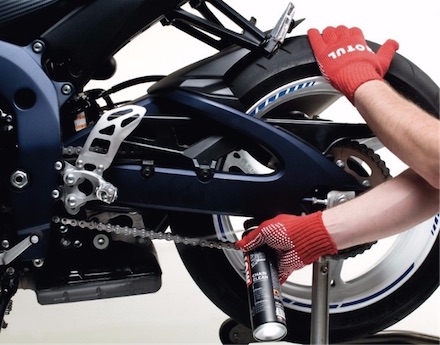Your motorcycle chain is a vital ingredient in making your bike smooth, quiet and efficient, so to prolong its life, it’s important to perform regular checks and maintenance.
French motorcycle lubricant company Motul, distributed in Australia by Link International, sent us a check list and technical details for lubricating your chain.
We’ve integrated their comments with our own experiences to provide you with a thorough guide to maintaining your motorcycle chain which will ensure a longer life.
CHECK
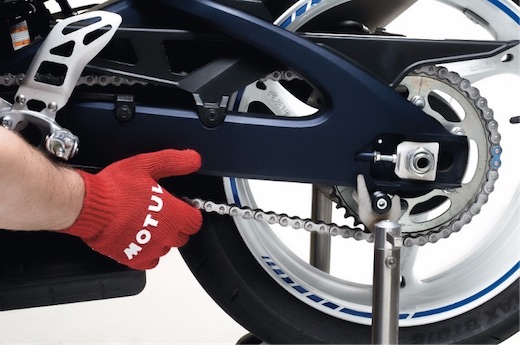
You should check your chain every 500-1000km for correct tension, adequate lubrication, and signs of wear such as blunt sprockets and scoured links.
READ HOW TO ADJUST CHAIN TENSION
You may want to check your chain more frequently if you’ve been doing stunts (clutch wheelies will put a lot of strain on a chain!), riding on dirt roads, doing track days, or riding in the rain.
In fact, you should regrease your chain after every extended journey in the rain which tends to wash a lot of the lubrication off the chain.
CLEAN
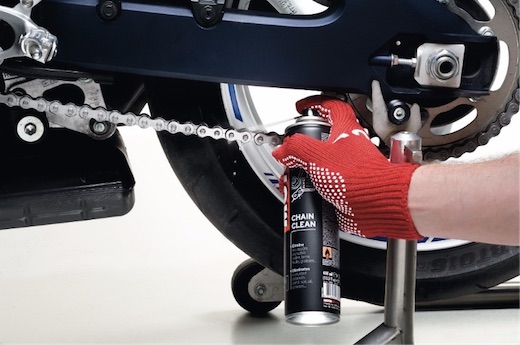
Before greasing the chain, you should remove any heavy grime. Over time, oil, dust and worn materials form pasty clumps which are abrasive and shorten the life of the chain.
We’ve used all sorts of spray-on degreasers to clean chains. Obviously Motul recommends their Chain Clean.
You’ll need to get the back wheel off the ground, either by the centre stand, paddock stand or some other arrangement.
Place a piece of cardboard or old rags on the floor under the chain or you may get grease all over your garage floor.
To apply the degreaser, turn the rear wheel by hand. Don’t turn on the engine and put it in gear as it will spin too fast and you could get your hand caught.
Spray the links on all sides with the degreasing solution until completely covered and leave it to soak in for a couple of minutes.
Clean the chain with a soft brush to get into all the links. Don’t use a metal brush as they can scour and damage the chain. Rub the chain dry with a soft cloth that won’t leave behind any fluff. You may have to repeat the process if there is stubborn grime.
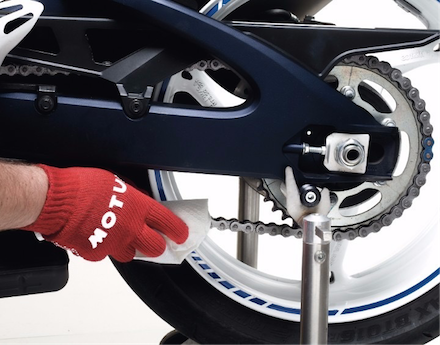
REGREASE
What product you use to regrease your chain may depend on what sort of riding you do. Motorcycle chain lubricants can consist of wax, lanolin, synthetic oils or mineral oils which have various advantages and disadvantages.
People who travel big distances prefer to avoid the hassle of constant maintenance by using an automatic chain oiler such as the Cameleon.
Motul recommends its Chain Lube Road for road-use motorcycles.
My Bonneville has chrome spoked wheels, so I prefer a wax or a paste such as Motul Chain Paste which doesn’t fling off and spoil your wheels. It comes with a brush integrated into the tube.
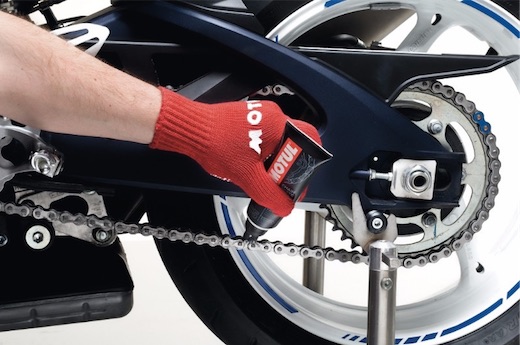
Whatever lube you use, make sure it is designed for a motorcycle chain.
When you apply lube, you should spray it on to the inside of the chain as it comes out from the sprocket. This will avoid getting lubricant on your wheel or tyre which can be dangerous and damage chrome and paint surfaces.
For safety, don’t switch on the engine and put the bike in gear to apply the lube. Turn the wheel by hand, making sure to keep a constant speed so you apply the lubricant evenly.
You only need a thin layer of lube. It will gradually seep into the rest of the chain. If it’s dripping, you’ve applied too much!
Do not ride off immediately after lubricating the chain as the grease will simply fling off.
Allow about 10-15 minutes for the solvents to air and achieve maximum adhesion.
The best time to lubricate a chain is when it is warm, after you’ve been out for a ride as the lube or paste will soak in better.


